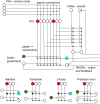Beyond prediction error: 25 years of modeling the associations formed in the insect mushroom body
- PMID: 38862164
- PMCID: PMC11199945
- DOI: 10.1101/lm.053824.123
Beyond prediction error: 25 years of modeling the associations formed in the insect mushroom body
Abstract
The insect mushroom body has gained increasing attention as a system in which the computational basis of neural learning circuits can be unraveled. We now understand in detail the key locations in this circuit where synaptic associations are formed between sensory patterns and values leading to actions. However, the actual learning rule (or rules) implemented by neural activity and leading to synaptic change is still an open question. Here, I survey the diversity of answers that have been offered in computational models of this system over the past decades, including the recurring assumption-in line with top-down theories of associative learning-that the core function is to reduce prediction error. However, I will argue, a more bottom-up approach may ultimately reveal a richer algorithmic capacity in this still enigmatic brain neuropil.
© 2024 Webb; Published by Cold Spring Harbor Laboratory Press.
Figures

References
Publication types
MeSH terms
LinkOut - more resources
Full Text Sources
Miscellaneous
